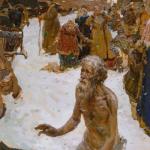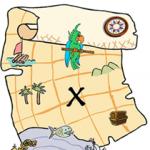The civil war in Russia is a series of armed conflicts of 1917-1922 that took place in the territories of the former Russian Empire. The opposing sides were various political, ethnic, social groups and state entities. The war began after the October Revolution, the main reason for which was the coming to power of the Bolsheviks. Let's take a closer look at the prerequisites, course and results of the Russian Civil War of 1917-1922.
periodization
The main stages of the Civil War in Russia:
- Summer 1917 - late autumn 1918 The main centers of the anti-Bolshevik movement were formed.
- Autumn 1918 - mid-spring 1919 The Entente began its intervention.
- Spring 1919 - spring 1920 The struggle of the Soviet authorities of Russia with the "white" armies and troops of the Entente.
- Spring 1920 - autumn 1922 The victory of power and the end of the war.
Prerequisites
There is no strictly defined cause of the Russian Civil War. It was the result of political, economic, social, national and even spiritual contradictions. An important role was played by the public discontent accumulated during the First World War and the devaluation of human life by the authorities. The agrarian-peasant Bolshevik policy also became an incentive for protest moods.
The Bolsheviks initiated the dissolution of the All-Russian Constituent Assembly and the liquidation of the multi-party system. In addition, after the adoption of the Brest Peace, they were accused of destroying the state. The right of self-determination of peoples and the formation of independent state formations in different parts of the country were perceived by supporters of indivisible Russia as a betrayal.
Dissatisfaction with the new government was also expressed by those who were against a break with the historical past. The anti-church Bolshevik policy caused a special resonance in society. All the reasons listed above came together and led to the Russian Civil War of 1917-1922.
The military confrontation took on all sorts of forms: clashes, guerrilla actions, terrorist attacks and large-scale operations involving the regular army. A feature of the Russian Civil War of 1917-1922 was that it stood out as exceptionally long, cruel and capturing vast territories.
Chronological framework
The Civil War in Russia of 1917-1922 began to take on a large-scale front-line character in the spring and summer of 1918, but separate episodes of confrontation took place as early as 1917. It is also difficult to determine the final boundary of events. On the territory of the European part of Russia, front-line battles ended in 1920. However, after that there were mass uprisings of peasants against Bolshevism and performances by Kronstadt sailors. In the Far East, the armed struggle ended altogether in 1922-1923. It is this milestone that is considered the end of a large-scale war. Sometimes you can find the phrase "Civil War in Russia 1918-1922" and other shifts of 1-2 years.

Confrontation Features
The military operations of 1917-1922 were fundamentally different from the battles of previous periods. They broke more than a dozen stereotypes regarding the management of units, the army command and control system and military discipline. Significant successes were achieved by those commanders who commanded in a new way, used all possible means to achieve the task. The civil war was very maneuverable. In contrast to the positional battles of previous years, solid front lines were not used in 1917-1922. Cities and towns could change hands several times. Of decisive importance were active offensives aimed at seizing the championship from the enemy.
The Russian Civil War of 1917-1922 was characterized by the use of diverse tactics and strategies. During the establishment in Moscow and Petrograd, street fighting tactics were used. In October 1917, the military revolutionary committee, headed by V. I. Lenin and N. I. Podvoisky, developed a plan to capture the main city facilities. During the battles in Moscow (autumn 1917), Red Guard detachments advanced from the outskirts to the center of the city, which was occupied by the White Guard and junkers. Artillery was used to suppress strongholds. Similar tactics were used during the establishment of Soviet power in Kyiv, Irkutsk, Kaluga and Chita.
Formation of the centers of the anti-Bolshevik movement
With the beginning of the formation of parts of the Red and White armies, the Civil War in Russia of 1917-1922 became more ambitious. In 1918, military operations were carried out, as a rule, along railway communications and were limited to the capture of important junction stations. This period was called the "echelon war".
In the first months of 1918, in Rostov-on-Don and Novocherkassk, where the forces of volunteer units of Generals L. G. Kornilov and M. V. Alekseev were concentrated, the Red Guards were advancing under the leadership of R. F. Siver and V. A. Antonov- Ovseyenko. In the spring of the same year, the Czechoslovak corps, formed from Austro-Hungarian prisoners of war, set off along the Trans-Siberian Railway to the Western Front. During May-June, this corps overthrew the authorities in Omsk, Krasnoyarsk, Tomsk, Vladivostok, Novonikolaevsk and throughout the territory adjacent to the Trans-Siberian Railway.

During the second Kuban campaign (summer-autumn 1918), the Volunteer Army took the junction stations: Tikhoretskaya, Torgovaya, Armavir and Stavropol, which actually determined the outcome of the North Caucasian operation.
The beginning of the Civil War in Russia was marked by the extensive activity of the underground organizations of the White movement. In the large cities of the country there were cells that were associated with the former military districts and military units of these cities, as well as local cadets, socialist-revolutionaries and monarchists. In the spring of 1918, the underground operated in Tomsk under the leadership of Lieutenant Colonel Pepelyaev, in Omsk - Colonel Ivanov-Rinov, in Nikolaevsk - Colonel Grishin-Almazov. In the summer of 1918, a secret regulation was approved regarding the recruiting centers for the army of volunteers in Kyiv, Odessa, Kharkov and Taganrog. They were engaged in the transfer of intelligence information, sent officers across the front line and intended to oppose the authorities when the White Army approached their home city.
The Soviet underground, which was active in the Crimea, Eastern Siberia, the North Caucasus and the Far East, had a similar function. It created very strong partisan detachments, which later became part of the regular units of the Red Army.
By the beginning of 1919, the White and Red armies were finally formed. The RKKR included 15 armies, which covered the entire front of the European part of the country. The highest military leadership was concentrated with L.D. Trotsky - Chairman of the Revolutionary Military Council of the Republic (RVSR) and S.S. Kamenev - Commander-in-Chief. The rear support of the front and the regulation of the economy in the territories of Soviet Russia was carried out by the STO (Council of Labor and Defense), whose chairman was Vladimir Ilyich Lenin. He also headed the Council of People's Commissars (Council of People's Commissars) - in fact, the Soviet government.
The Red Army was opposed by the united armies of the Eastern Front under the command of Admiral A. V. Kolchak: Western, Southern, Orenburg. They were also joined by the armies of the Commander-in-Chief of the VSYUR (Armed Forces of the South of Russia), Lieutenant General A. I. Denikin: Volunteer, Don and Caucasian. In addition, in the general Petrograd direction, the troops of the infantry general N.N. Yudenich - Commander-in-Chief of the North-Western Front and E.K. Miller - Commander-in-Chief of the Northern Region.

Intervention
The civil war and foreign intervention in Russia were closely linked. Intervention is called the armed intervention of foreign powers in the internal affairs of the country. Its main goals in this case are: to force Russia to continue fighting on the side of the Entente; protect personal interests in Russian territories; to provide financial, political and military support to the participants of the White movement, as well as to the governments of the countries formed after the October Revolution; and to prevent the ideas of the world revolution from penetrating the countries of Europe and Asia.
War development
In the spring of 1919, the first attempts at a combined strike by the "white" fronts were made. From this period, the Civil War in Russia acquired a large-scale character, all types of troops (infantry, artillery, cavalry) began to be used in it, military operations were conducted with the assistance of tanks, armored trains and aviation. In March 1919, the eastern front of Admiral Kolchak began its offensive, striking in two directions: on Vyatka-Kotlas and on the Volga.
The armies of the Soviet Eastern Front under the command of S. S. Kamenev at the beginning of June 1919 were able to contain the offensive of the Whites, inflicting counter blows on them in the Southern Urals and in the Kama region.
In the summer of the same year, the VSYUR began its offensive against Kharkov, Tsaritsyn and Yekaterinoslav. On July 3, when these cities were taken, Denikin signed the directive "On the March on Moscow." From that moment until October, the AFSR troops occupied the main part of Ukraine and the Black Earth Center of Russia. They stopped on the line Kyiv - Tsaritsyn, passing through Bryansk, Orel and Voronezh. Almost simultaneously with the withdrawal of the All-Union Socialist League to Moscow, the North-Western Army of General Yudenich went to Petrograd.
The autumn of 1919 became the most critical period for the Soviet army. Under the slogans "Everything - for the defense of Moscow" and "Everything - for the defense of Petrograd", a total mobilization of Komsomol members and communists was carried out. Control over the railway lines that converged to the center of Russia allowed the Revolutionary Military Council of the Republic to transfer troops between the fronts. So, at the height of the battles in the Moscow direction near Petrograd and to the Southern Front, several divisions were transferred from Siberia and the Western Front. At the same time, the White armies failed to establish a common anti-Bolshevik front. The only exceptions were a few local contacts at the squad level.
The concentration of forces from different fronts allowed Lieutenant General V.N. Yegorov, the commander of the southern front, to create a strike group, the basis of which were parts of the Estonian and Latvian rifle divisions, as well as the cavalry army of K.E. Voroshilov and S.M. Budyonny. Impressive blows were dealt to the flanks of the 1st Volunteer Corps, which was under the command of Lieutenant General A.P. Kutepov and advanced on Moscow.

After intense fighting in October-November 1919, the VSYUR front was broken and the Whites began to retreat from Moscow. In mid-November, units of the North-Western Army were stopped and defeated, which were 25 kilometers short of reaching Petrograd.
The battles of 1919 were notable for their extensive use of maneuver. In order to break through the front and conduct a raid behind enemy lines, large cavalry formations were used. The White Army used the Cossack cavalry for this purpose. So, the fourth Don Corps, under the leadership of Lieutenant General Mamontov, in the fall of 1919, made a deep raid from the city of Tambov to the Ryazan province. And the Siberian Cossack Corps, Major General Ivanov-Rinov, managed to break through the "red" front near Petropavlovsk. Meanwhile, the "Chervona Division" of the Southern Front of the Red Army made a raid on the rear of the volunteer corps. At the end of 1919, it began to decisively attack the Rostov and Novocherkassk directions.
In the first months of 1920, a fierce battle unfolded in the Kuban. As part of operations on the Manych River and near the village of Yegorlykskaya, the last massive horse battles in the history of mankind took place. The number of riders who took part in them from both sides was about 50 thousand. The result of the brutal confrontation was the defeat of the All-Union Socialist Revolutionary Federation. In April of the same year, the White troops began to be called the "Russian Army" and obey Lieutenant General Wrangel.
End of the war
In late 1919 - early 1920, the army of A.V. Kolchak was finally defeated. In February 1920, the admiral was shot by the Bolsheviks, and only small partisan detachments remained of his troops. A month earlier, after a couple of unsuccessful campaigns, General Yudenich announced the dissolution of the Northwestern Army. After the defeat of Poland, the army of P. N. Wrangel, locked in the Crimea, was doomed. In the autumn of 1920 (by the forces of the Southern Front of the Red Army), it was defeated. In this regard, about 150 thousand people (both military and civilian) left the peninsula. It seemed that the end of the Civil War in Russia of 1917-1922 was not far off, but everything was not so simple.

In 1920-1922, hostilities took place in small territories (Transbaikalia, Primorye, Tavria) and began to acquire elements of a positional war. For defense, fortifications began to be actively used, for the breakthrough of which the warring side needed long-term artillery preparation, as well as flamethrower and tank support.
The defeat of the army of P.N. Wrangel did not mean at all that the Civil War in Russia was over. The Reds still had to cope with the peasant insurrectionary movements, which called themselves "greens". The most powerful of them were deployed in the Voronezh and Tambov provinces. The rebel army was led by the Socialist-Revolutionary A. S. Antonov. She even managed to overthrow the Bolsheviks from power in several areas.
At the end of 1920, the fight against the rebels was entrusted to units of the regular Red Army under the control of M. N. Tukhachevsky. However, it turned out to be even more difficult to resist the partisans of the peasant army than the open pressure of the White Guards. The Tambov uprising of the "greens" was suppressed only in 1921. A. S. Antonov was killed in a shootout. Around the same time, Makhno's army was also defeated.
During 1920-1921, the Red Army made a number of campaigns in the Transcaucasus, as a result of which Soviet power was established in Azerbaijan, Armenia and Georgia. To suppress the White Guards and interventionists in the Far East, the Bolsheviks created the FER (Far Eastern Republic) in 1921. For two years, the army of the republic held back the onslaught of Japanese troops in Primorye and neutralized several White Guard atamans. She made a significant contribution to the outcome of the Civil War and intervention in Russia. At the end of 1922, the FER joined the RSFSR. In the same period, having defeated the Basmachi, who fought to preserve medieval traditions, the Bolsheviks consolidated their power in Central Asia. Speaking about the Civil War in Russia, it is worth noting that individual rebel groups operated until the 1940s.

Reasons for the Reds' victory
The superiority of the Bolsheviks in the Russian Civil War of 1917-1922 was due to the following reasons:
- Powerful propaganda and use of the political mood of the masses.
- Control of the central provinces of Russia, in which the main military enterprises were located.
- Disunity and territorial fragmentation of the Whites.
The main result of the events of 1917-1922 was the establishment of Bolshevik power. The revolution and civil war in Russia took about 13 million lives. Almost half of them became victims of mass epidemics and famine. About 2 million Russians left their homeland in those years to protect themselves and their families. During the years of the Civil War in Russia, the state's economy fell to catastrophic levels. In 1922, compared with pre-war data, industrial production decreased by 5-7 times, and agricultural - by a third. The empire was finally destroyed, and the RSFSR became the largest of the formed states.
Chronology
- 1918 I stage of the civil war - "democratic"
- 1918 June Nationalization Decree
- January 1919 Introduction of the surplus appraisal
- 1919 Fight against A.V. Kolchak, A.I. Denikin, Yudenich
- 1920 Soviet-Polish war
- 1920 Fight against P.N. Wrangel
- 1920 November End of the civil war in European territory
- 1922 October End of the civil war in the Far East
Civil war and military intervention
Civil War- “the armed struggle between different groups of the population, which was based on deep social, national and political contradictions, took place with the active intervention of foreign forces at various stages and stages ...” (Academician Yu.A. Polyakov).
In modern historical science there is no single definition of the concept of "civil war". In the encyclopedic dictionary we read: "Civil war is an organized armed struggle for power between classes, social groups, the most acute form of class struggle." This definition actually repeats Lenin's well-known saying that civil war is the most acute form of class struggle.
Currently, various definitions are given, but their essence basically boils down to the definition of the Civil War as a large-scale armed confrontation, in which, of course, the issue of power was decided. The seizure of state power in Russia by the Bolsheviks and the dispersal of the Constituent Assembly that followed soon after can be considered the beginning of an armed confrontation in Russia. The first shots are heard in the South of Russia, in the Cossack regions, already in the autumn of 1917.
General Alekseev, the last chief of staff of the tsarist army, begins to form a Volunteer Army on the Don, but by the beginning of 1918 it is no more than 3,000 officers and cadets.
As A.I. Denikin in "Essays on Russian Troubles", "the white movement grew spontaneously and inevitably."
During the first months of the victory of Soviet power, armed clashes were local in nature, all opponents of the new government gradually determined their strategy and tactics.
This confrontation took on a truly front-line, large-scale character in the spring of 1918. Let us single out three main stages in the development of armed confrontation in Russia, proceeding primarily from taking into account the balance of political forces and the specifics of the formation of fronts.
The first stage begins in the spring of 1918 when the military-political confrontation acquires a global character, large-scale military operations begin. The defining feature of this stage is its so-called "democratic" character, when representatives of the socialist parties came out as an independent anti-Bolshevik camp with slogans for the return of political power to the Constituent Assembly and the restoration of the gains of the February Revolution. It is this camp that chronologically outstrips the White Guard camp in its organizational design.
At the end of 1918, the second stage begins- confrontation between whites and reds. Until the beginning of 1920, one of the main political opponents of the Bolsheviks was the white movement with the slogans of "non-decision of the state system" and the elimination of Soviet power. This direction endangered not only the October, but also the February conquests. Their main political force was the Cadet Party, and the base for the formation of the army was the generals and officers of the former tsarist army. The Whites were united by their hatred of the Soviet regime and the Bolsheviks, the desire to preserve a united and indivisible Russia.
The final stage of the Civil War begins in 1920. the events of the Soviet-Polish war and the fight against P. N. Wrangel. The defeat of Wrangel at the end of 1920 marked the end of the Civil War, but anti-Soviet armed uprisings continued in many regions of Soviet Russia even during the years of the new economic policy.
nationwide scope armed struggle has acquired since the spring of 1918 and turned into the greatest disaster, the tragedy of the entire Russian people. In this war there were no right and wrong, winners and losers. 1918 - 1920 - in these years the military question was of decisive importance for the fate of the Soviet power and the bloc of anti-Bolshevik forces opposing it. This period ended with the liquidation in November 1920 of the last white front in the European part of Russia (in the Crimea). On the whole, the country emerged from the state of civil war in the fall of 1922 after the remnants of white formations and foreign (Japanese) military units were expelled from the territory of the Russian Far East.
A feature of the civil war in Russia was its close interweaving with anti-Soviet military intervention powers of the Entente. It acted as the main factor in prolonging and exacerbating the bloody "Russian turmoil".
So, in the periodization of the civil war and intervention, three stages are quite clearly distinguished. The first of them covers the time from spring to autumn 1918; the second - from the autumn of 1918 to the end of 1919; and the third - from the spring of 1920 to the end of 1920.
The first stage of the civil war (spring - autumn 1918)
In the first months of the establishment of Soviet power in Russia, armed clashes were local in nature, all opponents of the new government gradually determined their strategy and tactics. Armed struggle acquired a nationwide scale in the spring of 1918. Back in January 1918, Romania, taking advantage of the weakness of the Soviet government, captured Bessarabia. In March-April 1918, the first contingents of troops from England, France, the USA and Japan appeared on Russian territory (in Murmansk and Arkhangelsk, in Vladivostok, in Central Asia). They were small and could not noticeably influence the military and political situation in the country. "War Communism"
At the same time, the enemy of the Entente - Germany - occupied the Baltic states, part of Belarus, Transcaucasia and the North Caucasus. The Germans actually dominated Ukraine: they overthrew the bourgeois-democratic Verkhovna Rada, whose help they used during the occupation of Ukrainian lands, and in April 1918 put Hetman P.P. Skoropadsky.
Under these conditions, the Supreme Council of the Entente decided to use the 45,000th Czechoslovak Corps, who was (in agreement with Moscow) subordinate to him. It consisted of captured Slavic soldiers of the Austro-Hungarian army and followed the railroad to Vladivostok for subsequent transfer to France.
According to an agreement concluded on March 26, 1918 with the Soviet government, the Czechoslovak legionnaires were to advance "not as a combat unit, but as a group of citizens with weapons in order to repel the armed attacks of counter-revolutionaries." However, during the movement, their conflicts with local authorities became more frequent. Since the Czechs and Slovaks had more military weapons than provided for in the agreement, the authorities decided to confiscate them. On May 26, in Chelyabinsk, conflicts escalated into real battles, and the legionnaires occupied the city. Their armed action was immediately supported by the military missions of the Entente in Russia and the anti-Bolshevik forces. As a result, in the Volga region, in the Urals, in Siberia and in the Far East - wherever there were echelons with Czechoslovak legionnaires - Soviet power was overthrown. At the same time, in many provinces of Russia, the peasants, dissatisfied with the food policy of the Bolsheviks, revolted (according to official data, there were at least 130 major anti-Soviet peasant uprisings alone).
Socialist parties(mainly right SRs), relying on interventionist landings, the Czechoslovak Corps and peasant rebel detachments, formed a number of governments Komuch (Committee of members of the Constituent Assembly) in Samara, the Supreme Administration of the Northern Region in Arkhangelsk, the West Siberian Commissariat in Novonikolaevsk (now Novosibirsk), The Provisional Siberian Government in Tomsk, the Trans-Caspian Provisional Government in Ashgabat, etc. In their activities, they tried to compose “ democratic alternative”both the Bolshevik dictatorship and the bourgeois-monarchist counter-revolution. Their programs included demands for the convocation of a Constituent Assembly, the restoration of the political rights of all citizens without exception, freedom of trade and the rejection of strict state regulation of the economic activities of peasants while maintaining a number of important provisions of the Soviet Decree on Land, the establishment of a “social partnership” between workers and capitalists during the denationalization of industrial enterprises and etc.
Thus, the performance of the Czechoslovak corps gave impetus to the formation of the front, which bore the so-called "democratic coloring" and was mainly Socialist-Revolutionary. It was this front, and not the white movement, that was decisive at the initial stage of the Civil War.
In the summer of 1918, all opposition forces became a real threat to the Bolshevik government, which controlled only the territory of the center of Russia. The territory controlled by Komuch included the Volga region and part of the Urals. Bolshevik power was also overthrown in Siberia, where a regional government of the Siberian Duma was formed. The breakaway parts of the empire - Transcaucasia, Central Asia, the Baltic States - had their own national governments. The Germans captured the Ukraine, the Don and Kuban were captured by Krasnov and Denikin.
On August 30, 1918, a terrorist group killed the chairman of the Petrograd Cheka, Uritsky, and the right-wing Socialist-Revolutionary Kaplan seriously wounded Lenin. The threat of losing political power to the ruling Bolshevik Party became catastrophically real.
In September 1918, a meeting of representatives of a number of anti-Bolshevik governments of democratic and social orientation was held in Ufa. Under the pressure of the Czechoslovaks, who threatened to open the front to the Bolsheviks, they established a single All-Russian government - the Ufa directory, headed by the leaders of the Socialist-Revolutionaries N.D. Avksentiev and V.M. Zenzinov. Soon the directory settled in Omsk, where the well-known polar explorer and scientist, the former commander of the Black Sea Fleet, Admiral A.V., was invited to the post of Minister of War. Kolchak.
The right, bourgeois-monarchist wing of the camp opposing the Bolsheviks as a whole had not yet recovered at that time from the defeat of its first post-October armed onslaught on them (which largely explained the “democratic coloring” of the initial stage of the civil war on the part of anti-Soviet forces). The White Volunteer Army, which, after the death of General L.G. Kornilov in April 1918 was headed by General A.I. Denikin, operated on a limited territory of the Don and Kuban. Only the Cossack army of ataman P.N. Krasnov managed to advance to Tsaritsyn and cut off the grain regions of the North Caucasus from the central regions of Russia, and Ataman A.I. Dutov - to capture Orenburg.
The position of Soviet power by the end of the summer of 1918 became critical. Almost three-quarters of the territory of the former Russian Empire was under the control of various anti-Bolshevik forces, as well as the occupying Austro-German troops.

Soon, however, a turning point occurs on the main front (Eastern). Soviet troops under the command of I.I. Vatsetis and S.S. Kamenev in September 1918 went on the offensive there. Kazan fell first, then Simbirsk, and Samara in October. By winter, the Reds approached the Urals. The attempts of General P.N. Krasnov to capture Tsaritsyn, undertaken in July and September 1918.
From October 1918, the Southern Front became the main one. In the South of Russia, the Volunteer Army of General A.I. Denikin captured the Kuban, and the Don Cossack army of Ataman P.N. Krasnova tried to take Tsaritsyn and cut the Volga.
The Soviet government launched active actions to protect its power. In 1918, a transition was made to universal conscription, a broad mobilization was launched. The constitution, adopted in July 1918, established discipline in the army and introduced the institution of military commissars.

As part of the Central Committee, the Politburo of the Central Committee of the RCP (b) was allocated for the prompt solution of problems of a military and political nature. It included: V.I. Lenin --Chairman of the Council of People's Commissars; L.B. Krestinsky - Secretary of the Central Committee of the Party; I.V. Stalin - People's Commissar for Nationalities; L.D. Trotsky - Chairman of the Revolutionary Military Council of the Republic, People's Commissar for Military and Naval Affairs. Candidate members were N.I. Bukharin - editor of the newspaper Pravda, G.E. Zinoviev - Chairman of the Petrograd Soviet, M.I. Kalinin - Chairman of the All-Russian Central Executive Committee.
Under the direct control of the Central Committee of the party, the Revolutionary Military Council of the Republic, headed by L.D. Trotsky. The institute of military commissars was introduced in the spring of 1918, one of its important tasks was to control the activities of military specialists - former officers. By the end of 1918, there were about 7,000 commissars in the Soviet armed forces. About 30% of the former generals and officers of the old army during the Civil War came out on the side of the Red Army.
This was determined by two main factors:
- speaking on the side of the Bolshevik government for ideological reasons;
- the policy of attracting "military specialists" to the Red Army - former tsarist officers - was carried out by L.D. Trotsky using repressive methods.
war communism
In 1918, the Bolsheviks introduced a system of emergency measures, economic and political, known as “ war communism policy”. Basic acts this policy became Decree of May 13, 1918 g., giving broad powers to the People's Commissariat for Food (People's Commissariat for Food), and Decree of 28 June 1918 on nationalization.
The main provisions of this policy:
- nationalization of all industry;
- centralization of economic management;
- prohibition of private trade;
- curtailment of commodity-money relations;
- food allocation;
- an equalizing system of wages for workers and employees;
- wages in kind for workers and employees;
- free public services;
- universal labor service.
June 11, 1918 were created combos(committees of the poor), which were supposed to seize surplus agricultural products from wealthy peasants. Their actions were supported by parts of the prodarmiya (food army), consisting of Bolsheviks and workers. From January 1919, the search for surpluses was replaced by a centralized and planned system of surplus appropriations (Reader T8 No. 5).
Each region and county had to hand over a fixed amount of grain and other products (potatoes, honey, butter, eggs, milk). When the rate of change was met, the villagers received a receipt for the right to purchase manufactured goods (cloth, sugar, salt, matches, kerosene).
June 28, 1918 the state has started nationalization of enterprises with a capital of more than 500 rubles. Back in December 1917, when the Supreme Economic Council (Supreme Council of the National Economy) was created, he took up nationalization. But the nationalization of labor was not massive (by March 1918 no more than 80 enterprises had been nationalized). It was primarily a repressive measure against entrepreneurs who resisted workers' control. Now it was government policy. By November 1, 1919, 2,500 enterprises had been nationalized. In November 1920, a decree was issued extending the nationalization to all enterprises with more than 10 or 5 workers, but using a mechanical engine.
Decree of November 21, 1918 was established monopoly on internal trade. The Soviet government replaced trade with state distribution. Citizens received food through the system of the People's Commissariat for Food on cards, of which, for example, in Petrograd in 1919 there were 33 types: bread, dairy, shoe, etc. The population was divided into three categories:
workers and scientists and artists equated to them;
employees;
former exploiters.
Due to the lack of food, even the wealthiest received only ¼ of the prescribed ration.
Under such conditions, the “black market” flourished. The government fought the "pouchers" by forbidding them to travel by train.
In the social sphere, the policy of "war communism" was based on the principle "who does not work, he does not eat." In 1918, labor service was introduced for representatives of the former exploiting classes, and in 1920, universal labor service.
In the political sphere"war communism" meant the undivided dictatorship of the RCP (b). The activities of other parties (the Cadets, Mensheviks, Right and Left Socialist-Revolutionaries) were banned.
The consequences of the policy of "war communism" were the deepening of economic ruin, the reduction of production in industry and agriculture. However, it was precisely this policy that in many ways allowed the Bolsheviks to mobilize all the resources and win the Civil War.
The Bolsheviks assigned a special role in the victory over the class enemy to mass terror. On September 2, 1918, the All-Russian Central Executive Committee adopted a resolution proclaiming the beginning of "mass terror against the bourgeoisie and its agents." Head of the Cheka F.E. Dzherzhinsky said: "We are terrorizing the enemies of Soviet power." The policy of mass terror assumed a state character. Shooting on the spot became commonplace.
The second stage of the civil war (autumn 1918 - late 1919)
From November 1918, the front-line war entered the stage of confrontation between the Reds and the Whites. The year 1919 became decisive for the Bolsheviks, a reliable and constantly growing Red Army was created. But their opponents, actively supported by former allies, united among themselves. The international situation has also changed drastically. Germany and her allies in the world war laid down their arms before the Entente in November. Revolutions took place in Germany and Austria-Hungary. Leadership of the RSFSR November 13, 1918 annulled, and the new governments of these countries were forced to evacuate their troops from Russia. Bourgeois-national governments arose in Poland, the Baltic States, Belarus, and the Ukraine, which immediately took the side of the Entente.
The defeat of Germany freed up significant combat contingents of the Entente and at the same time opened up for her a convenient and short road to Moscow from the southern regions. Under these conditions, the intention to crush Soviet Russia with the forces of its own armies prevailed in the Entente leadership.
In the spring of 1919, the Supreme Council of the Entente developed a plan for the next military campaign. (Reader T8 No. 8) As noted in one of his secret documents, the intervention was to be "expressed in the combined military operations of the Russian anti-Bolshevik forces and the armies of neighboring allied states." At the end of November 1918, a combined Anglo-French squadron of 32 pennants (12 battleships, 10 cruisers and 10 destroyers) appeared off the Black Sea coast of Russia. British troops landed in Batum and Novorossiysk, and French troops landed in Odessa and Sevastopol. The total number of interventionist combat forces concentrated in the south of Russia was increased by February 1919 to 130 thousand people. Entente contingents increased significantly in the Far East and Siberia (up to 150,000 men) and also in the North (up to 20,000 men).

In Siberia, on November 18, 1918, Admiral A.V. came to power. Kolchak. . He put an end to the disorderly actions of the anti-Bolshevik coalition.
Having dispersed the Directory, he proclaimed himself the Supreme Ruler of Russia (the rest of the leaders of the white movement soon declared subordination to him). Admiral Kolchak in March 1919 began to advance on a broad front from the Urals to the Volga. The main bases of his army were Siberia, the Urals, the Orenburg province and the Ural region. In the north, from January 1919, General E.K. began to play the leading role. Miller, in the northwest - General N.N. Yudenich. In the south, the dictatorship of the commander of the Volunteer Army A.I. Denikin, who in January 1919 subjugated the Don Army of General P.N. Krasnov and created the united Armed Forces of the South of Russia.

In March 1919, the well-armed 300,000-strong army of A.V. Kolchak launched an offensive from the east, intending to unite with Denikin's forces for a joint attack on Moscow. Having captured Ufa, the Kolchakites fought their way to Simbirsk, Samara, Votkinsk, but were soon stopped by the Red Army. At the end of April, Soviet troops under the command of S.S. Kamenev and M.V. The Frunze went on the offensive and in the summer advanced deep into Siberia. By the beginning of 1920, the Kolchakites were finally defeated, and the admiral himself was arrested and shot by the verdict of the Irkutsk Revolutionary Committee.
In the summer of 1919, the center of the armed struggle moved to the Southern Front. (Reader T8 No. 7) On July 3, General A.I. Denikin issued his famous "Moscow Directive", and his army of 150,000 men launched an offensive along the entire 700-kilometer front from Kyiv to Tsaritsin. The White Front included such important centers as Voronezh, Orel, Kyiv. In this space of 1 million square meters. km with a population of up to 50 million people located 18 provinces and regions. By mid-autumn, Denikin's army captured Kursk and Orel. But by the end of October, the troops of the Southern Front (commander A.I. Yegorov) defeated the white regiments, and then began to push them along the entire front line. The remnants of Denikin's army, headed by General P.N. Wrangel, strengthened in the Crimea.
The final stage of the civil war (spring-autumn 1920)
At the beginning of 1920, as a result of hostilities, the outcome of the front-line Civil War was actually decided in favor of the Bolshevik government. At the final stage, the main hostilities were associated with the Soviet-Polish war and the fight against Wrangel's army.
Significantly aggravated the nature of the civil war Soviet-Polish war. Head of the Polish State Marshal Y. Pilsudsky hatched a plan to create " Greater Poland within the borders of 1772” from the Baltic Sea to the Black Sea, including a large part of the Lithuanian, Belarusian and Ukrainian lands, including those never controlled by Warsaw. The Polish national government was supported by the Entente countries, which sought to create a "sanitary bloc" of Eastern European countries between Bolshevik Russia and the West. On April 17, Pilsudski ordered an attack on Kyiv and signed an agreement with Ataman Petliura, Poland recognized the Directory headed by Petliura as the supreme power of Ukraine. May 7 Kyiv was taken. The victory was won unusually easily, because the Soviet troops withdrew without serious resistance.
But already on May 14, a successful counter-offensive of the troops of the Western Front (commander M.N. Tukhachevsky) began, and on May 26 - the South-Western Front (commander A.I. Egorov). In mid-July, they reached the borders of Poland. On June 12, Soviet troops occupied Kyiv. The speed of a victory won can only be compared with the speed of an earlier defeat.

On July 12, British Foreign Secretary Lord D. Curzon sent a note to the Soviet government - in fact, an ultimatum from the Entente demanding to stop the Red Army's advance on Poland. As a truce, the so-called “ Curzon line”, which took place mainly along the ethnic border of the settlement of the Poles.
The Politburo of the Central Committee of the RCP (b), clearly overestimating its own strength and underestimating the strength of the enemy, set a new strategic task for the high command of the Red Army: to continue the revolutionary war. IN AND. Lenin believed that the victorious entry of the Red Army into Poland would cause uprisings of the Polish working class and revolutionary uprisings in Germany. For this purpose, the Soviet government of Poland was promptly formed - the Provisional Revolutionary Committee consisting of F.E. Dzerzhinsky, F.M. Kona, Yu.Yu. Marchlevsky and others.
This attempt ended in disaster. The troops of the Western Front in August 1920 were defeated near Warsaw.
In October, the belligerents signed an armistice, and in March 1921, a peace treaty. Under its terms, a significant part of the lands in the west of Ukraine and Belarus went to Poland.
In the midst of the Soviet-Polish war, General P.N. Wrangell. With the help of harsh measures, up to public executions of demoralized officers, and relying on the support of France, the general turned Denikin's scattered divisions into a disciplined and combat-ready Russian army. In June 1920, an assault was landed from the Crimea on the Don and Kuban, and the main forces of the Wrangelites were thrown into the Donbass. On October 3, the offensive of the Russian army began in a northwestern direction towards Kakhovka.
The offensive of the Wrangel troops was repulsed, and during the operation launched on October 28 by the army of the Southern Front under the command of M.V. Frunze completely captured the Crimea. On November 14-16, 1920, an armada of ships under the St. Andrew's flag left the shores of the peninsula, taking away the broken white regiments and tens of thousands of civilian refugees to a foreign land. Thus, P.N. Wrangel saved them from the merciless red terror that hit the Crimea immediately after the evacuation of the Whites.
In the European part of Russia, after the capture of the Crimea, it was liquidated last white front. The military question ceased to be the main one for Moscow, but the fighting on the outskirts of the country continued for many more months.
The Red Army, having defeated Kolchak, went out in the spring of 1920 to Transbaikalia. The Far East was at that time in the hands of Japan. To avoid a collision with it, the government of Soviet Russia contributed to the formation in April 1920 of a formally independent "buffer" state - the Far Eastern Republic (FER) with its capital in the city of Chita. Soon, the army of the Far East began military operations against the White Guards, supported by the Japanese, and in October 1922 occupied Vladivostok, completely clearing the Far East of whites and invaders. After that, it was decided to liquidate the FER and include it in the RSFSR.

The Civil War became the biggest drama of the 20th century and the greatest tragedy of Russia. The armed struggle that unfolded in the vastness of the country was carried out with extreme tension of the forces of the opponents, was accompanied by mass terror (both white and red), and was distinguished by exceptional mutual bitterness. Here is an excerpt from the memoirs of a participant in the Civil War, who talks about the soldiers of the Caucasian Front: “Well, how, son, is it not scary for a Russian to beat a Russian?” — the comrades ask the recruit. “At first it really seems awkward,” he replies, “and then, if the heart is inflamed, then no, nothing.” These words contain the merciless truth about the fratricidal war, in which almost the entire population of the country was drawn.
The fighting parties clearly understood that the struggle could only have a fatal outcome for one of the parties. That is why the civil war in Russia became a great tragedy for all its political camps, movements and parties.
“Red” (Bolsheviks and their supporters) believed that they were defending not only Soviet power in Russia, but also “the world revolution and the ideas of socialism.”
In the political struggle against Soviet power, two political movements consolidated:
- democratic counterrevolution with slogans for the return of political power to the Constituent Assembly and the restoration of the gains of the February (1917) revolution (many Social Revolutionaries and Mensheviks advocated the establishment of Soviet power in Russia, but without the Bolsheviks (“For Soviets without Bolsheviks”));
- white movement with the slogans of "non-decision of the state system" and the elimination of Soviet power. This direction endangered not only the October, but also the February conquests. The counter-revolutionary white movement was not homogeneous. It included monarchists and liberal republicans, supporters of the Constituent Assembly and supporters of the military dictatorship. Among the “whites” there were also differences in foreign policy guidelines: some hoped for the support of Germany (Ataman Krasnov), others - for the help of the Entente powers (Denikin, Kolchak, Yudenich). The “Whites” were united by their hatred of the Soviet regime and the Bolsheviks, the desire to preserve a united and indivisible Russia. They did not have a single political program, the military in the leadership of the “white movement” pushed politicians into the background. There was also no clear coordination of actions between the main groups of "whites". The leaders of the Russian counter-revolution were competing and at enmity with each other.
In the anti-Soviet anti-Bolshevik camp, part of the political opponents of the Soviets acted under a single SR-White Guard flag, part - only under the White Guard.
Bolsheviks had a stronger social base than their opponents. They received the decisive support of the workers of the cities and the rural poor. The position of the main peasant mass was not stable and unequivocal, only the poorest part of the peasants consistently followed the Bolsheviks. The peasants' vacillation had its own reasons: the "Reds" gave land, but then introduced a surplus appropriation, which caused strong discontent in the countryside. However, the return of the old order was also unacceptable for the peasantry: the victory of the “whites” threatened the return of land to the landowners and severe punishments for the destruction of landlord estates.
The Socialist-Revolutionaries and Anarchists hurried to take advantage of the vacillations of the peasants. They managed to involve a significant part of the peasantry in the armed struggle, both against the whites and against the reds.
For both warring parties, it was also important what position the Russian officers would take in the conditions of the civil war. Approximately 40% of the officers of the tsarist army joined the “white movement”, 30% sided with the Soviet government, 30% evaded participation in the civil war.
The Russian Civil War escalated armed intervention foreign powers. The interventionists conducted active military operations on the territory of the former Russian Empire, occupied some of its regions, contributed to inciting a civil war in the country and contributed to its prolongation. The intervention turned out to be an important factor in the “revolutionary all-Russian turmoil”, multiplied the number of victims.
The civil war that took place in Russia from 1917 to 1922 was a bloody event, where in a brutal massacre brother went against brother, and relatives took up positions on opposite sides of the barricades. In this armed class clash on the vast territory of the former Russian Empire, the interests of opposing political structures intersected, conditionally divided into “reds” and “whites”. This struggle for power took place with the active support of foreign states that tried to extract their interests from this situation: Japan, Poland, Turkey, Romania wanted to annex part of the Russian territories, while other countries - the USA, France, Canada, Great Britain expected to receive tangible economic preferences.
As a result of such a bloody civil war, Russia turned into a weakened state, the economy and industry of which were in a state of complete ruin. But after the end of the war, the country adhered to the socialist course of development, and this influenced the course of history throughout the world.
Causes of the civil war in Russia
A civil war in any country is always caused by aggravated political, national, religious, economic and, of course, social contradictions. The territory of the former Russian Empire was no exception.
- Social inequality in Russian society has been accumulating for centuries, and at the beginning of the 20th century it reached its apogee, since the workers and peasants found themselves in an absolutely powerless position, and their working and living conditions were simply unbearable. The autocracy did not want to smooth out social contradictions and carry out any significant reforms. It was during this period that the revolutionary movement grew, which managed to lead the Bolshevik parties.
- Against the backdrop of the protracted First World War, all these contradictions became noticeably aggravated, which resulted in the February and October revolutions.
- As a result of the revolution in October 1917, the political system in the state changed, and the Bolsheviks came to power in Russia. But the overthrown classes could not reconcile themselves to the situation and made attempts to restore their former dominance.
- The establishment of Bolshevik power led to the rejection of the ideas of parliamentarism and the creation of a one-party system, which prompted the parties of the Cadets, Socialist-Revolutionaries, and Mensheviks to fight Bolshevism, that is, the struggle between the “whites” and the “reds” began.
- In the fight against the enemies of the revolution, the Bolsheviks used non-democratic measures - the establishment of a dictatorship, repression, the persecution of the opposition, the creation of emergency bodies. This, of course, caused discontent in society, and among those dissatisfied with the actions of the authorities were not only the intelligentsia, but also workers and peasants.
- The nationalization of land and industry caused resistance from the former owners, which led to terrorist actions on both sides.
- Despite the fact that Russia ceased its participation in the First World War in 1918, a powerful interventionist group was present on its territory, which actively supported the White Guard movement.
The course of the civil war in Russia
Before the start of the civil war, there were regions on the territory of Russia that were loosely interconnected: in some of them, Soviet power was firmly established, while others (south of Russia, the Chita region) were under the rule of independent governments. On the territory of Siberia, in general, one could count up to two dozen local governments, not only not recognizing the power of the Bolsheviks, but also at enmity with each other.

When the civil war began, then all the inhabitants had to decide, that is, to join the “whites” or “reds”.
The course of the civil war in Russia can be divided into several periods.
First period: October 1917 to May 1918
At the very beginning of the fratricidal war, the Bolsheviks had to suppress local armed rebellions in Petrograd, Moscow, Transbaikalia and the Don. It was at this time that a white movement was formed from those dissatisfied with the new government. In March, the young republic, after an unsuccessful war, concluded the shameful Treaty of Brest-Litovsk.
Second period: June to November 1918
At this time, a full-scale civil war began: the Soviet Republic was forced to fight not only with internal enemies, but also with interventionists. As a result, most of the Russian territory was captured by enemies, and this threatened the existence of the young state. In the east of the country, Kolchak dominated, in the south Denikin, in the north Miller, and their armies tried to close the ring around the capital. The Bolsheviks, in turn, created the Red Army, which achieved its first military successes.
Third period: November 1918 to spring 1919
In November 1918, the First World War ended. Soviet power was established in the Ukrainian, Belarusian and Baltic territories. But already at the end of autumn, the Entente troops landed in the Crimea, Odessa, Batumi and Baku. But this military operation was not crowned with success, since revolutionary anti-war sentiments reigned in the troops of the interventionists. During this period of the struggle against Bolshevism, the leading role belonged to the armies of Kolchak, Yudenich and Denikin.
Fourth Period: Spring 1919 to Spring 1920
During this period, the main forces of the interventionists left Russia. In the spring and autumn of 1919, the Red Army won major victories in the East, South and North-West of the country, defeating the armies of Kolchak, Denikin and Yudenich.

Fifth period: spring-autumn 1920
The internal counter-revolution was completely destroyed. And in the spring the Soviet-Polish war began, which ended in complete failure for Russia. According to the Riga Peace Treaty, part of the Ukrainian and Belarusian lands went to Poland.
Sixth period:: 1921-1922
During these years, all the remaining centers of the civil war were liquidated: the rebellion in Kronstadt was suppressed, the Makhnovist detachments were destroyed, the Far East was liberated, the struggle against the Basmachi in Central Asia was completed.
The results of the civil war
- As a result of hostilities and terror, more than 8 million people died from hunger and disease.
- Industry, transport and agriculture were on the verge of disaster.
- The main result of this terrible war was the final assertion of Soviet power.
The civil war is one of the bloodiest pages in the history of our country in the 20th century. The front line in this war did not pass through fields and forests, but in the souls and minds of people, forcing a brother to shoot at his brother, and a son to raise a saber against his father.
Beginning of the Russian Civil War 1917-1922
In October 1917, the Bolsheviks came to power in Petrograd. The period of the establishment of Soviet power was distinguished by the swiftness and speed with which the Bolsheviks established control over military depots, infrastructure and created new armed detachments.
The Bolsheviks had extensive social support thanks to the decrees on peace and land. This massive support compensated for the poor organization and combat training of the Bolshevik detachments.
At the same time, mainly among the educated part of the population, which was based on the nobility and the middle class, there was an understanding that the Bolsheviks came to power illegitimately, and, therefore, they should be fought. The political struggle was lost, only the armed one remained.
Causes of the Civil War
Any step taken by the Bolsheviks gave them both a new army of supporters and opponents. Therefore, the citizens of the Russian Republic had reason to organize armed resistance to the Bolsheviks.
The Bolsheviks demolished the front, seized power, launched terror. This could not help but force those whom they used to take up the rifle as a bargaining chip in the future construction of socialism.
The nationalization of the land caused discontent among those who owned it. This immediately turned the bourgeoisie and landlords against the Bolsheviks.
TOP 5 articleswho read along with this
The "dictatorship of the proletariat" promised by V. I. Lenin turned out to be the dictatorship of the Central Committee. The publication of the decree "On the arrest of the leaders of the Civil War" in November 1917 and on the "Red Terror" allowed the Bolsheviks to calmly exterminate their opposition. This caused retaliatory aggression on the part of the Socialist-Revolutionaries, Mensheviks and anarchists.

Rice. 1. Lenin in October.
The methodology of the government did not correspond to the slogans that the Bolshevik Party put forward during its coming to power, which forced the kulaks, the Cossacks and the bourgeoisie to turn away from them.
And, finally, seeing how the empire was collapsing, the neighboring states actively tried to get personal benefit from the political processes taking place on the territory of Russia.
Date of the beginning of the Civil War in Russia
There is no consensus on the exact date. Some historians believe that the conflict began immediately after the October Revolution, others call the beginning of the war in the spring of 1918, when foreign intervention took place and opposition to Soviet power was formed.
There is also no single point of view on the question of who is to blame at the beginning of the Civil War: the Bolsheviks or those who began to resist them.
First stage of the war
After the dispersal of the Constituent Assembly by the Bolsheviks, among the dispersed representatives there were those who did not agree with this and were ready to fight. They fled from Petrograd to territories not controlled by the Bolsheviks - to Samara. There they formed the Committee of Members of the Constituent Assembly (Komuch) and declared themselves the only legitimate authority and made it their task to overthrow the power of the Bolsheviks. The Komuch of the first convocation included five Social Revolutionaries.

Rice. 2. Members of the Komuch of the first convocation.
Forces opposing Soviet power were also formed in many regions of the former empire. Let's show them in the table:
In the spring of 1918, Germany occupied the Ukraine, the Crimea, and part of the North Caucasus; Romania - Bessarabia; England, France and the United States landed in Murmansk, while Japan deployed its troops in the Far East. In May 1918, the uprising of the Czechoslovak Corps also took place. So Soviet power was overthrown in Siberia, and in the south the Volunteer Army, having laid the foundation of the White Army "Armed Forces of the South of Russia", set off on the famous Ice Campaign, freeing the Don steppes from the Bolsheviks. Thus ended the first phase of the Civil War.

Rice. 3. Portrait of L. G. Kornilov.
What have we learned?
The beginning of the Civil War was marked by the establishment of Soviet power, followed by the formation of centers of resistance in all the outskirts of the former Russian Empire and foreign intervention.
Topic quiz
Report Evaluation
Average rating: 4.2. Total ratings received: 897.
The Civil War is one of the bloodiest conflicts in the history of the Russian people. For many decades, the Russian Empire demanded reforms. Seizing the moment, the Bolsheviks seized power in the country by killing the tsar. Supporters of the monarchy did not plan to cede influence and created the White movement, which was supposed to return the old state system. The fighting on the territory of the empire changed the further development of the country - it turned into a socialist state under the rule of the communist party.
In contact with
Civil war in Russia (Russian Republic) in 1917-1922.
In short, the Civil War is a turning point that changed fate forever Russian people: its result was the victory over tsarism and the seizure of power by the Bolsheviks.
The civil war in Russia (Russian Republic) took place between 1917 and 1922 between two opposing sides: supporters of the monarchy and its opponents, the Bolsheviks.
Features of the Civil War consisted in the fact that many foreign countries also took part in it, including France, Germany and Great Britain.
Important! The participants in the hostilities - white and red - during the Civil War destroyed the country, putting it on the verge of a political, economic and cultural crisis.
The civil war in Russia (Russian Republic) is one of the bloodiest in the 20th century, during which more than 20 million military and civilians died.
Fragmentation of the Russian Empire during the Civil War. September 1918.
Causes of the Civil War
Historians still do not agree on the causes of the Civil War, which took place from 1917 to 1922. Of course, everyone is of the opinion that the main reason is political, ethnic and social contradictions, which were never resolved during the mass protests of the Petrograd workers and military in February 1917.
As a result, the Bolsheviks came to power and carried out a number of reforms, which are considered to be the main prerequisites for the split of the country. At present, historians agree that The key reasons were:
- liquidation of the Constituent Assembly;
- way out by signing the Brest peace treaty, which is humiliating for the Russian people;
- pressure on the peasantry;
- the nationalization of all industrial enterprises and the elimination of private property, which caused a storm of discontent among people who lost their property.
Background of the Civil War in Russia (Russian Republic) (1917-1922):
- the formation of the Red and White movement;
- creation of the Red Army;
- local skirmishes between monarchists and Bolsheviks in 1917;
- execution of the royal family.

Stages of the Civil War
Attention! Most historians believe that the beginning of the Civil War should be dated 1917. Others deny this fact, since large-scale hostilities began to occur only in 1918.
Table the generally recognized stages of the Civil War are highlighted 1917-1922:
| War periods | Description |
| During this period, anti-Bolshevik centers are formed - the White movement. Germany moves troops to the eastern border of Russia, where small skirmishes with the Bolsheviks begin. In May 1918, an uprising of the Czechoslovak Corps takes place, against which the commander-in-chief of the Red Army, General Vatsetis, opposes. During the fighting in the fall of 1918, the Czechoslovak Corps was defeated and retreated beyond the Urals. |
|
|
Stage II (late November 1918 - winter 1920) |
After the defeat of the Czechoslovak Corps, the coalition of the Entente countries begins hostilities against the Bolsheviks, supporting the White movement. In November 1918, the White Guard Admiral Kolchak launched an offensive in the East of the country. The generals of the Red Army are defeated and in December of the same year they surrender the key city of Perm. By the forces of the Red Army at the end of 1918, the offensive of the Whites was stopped. In the spring, hostilities begin again - Kolchak conducts an offensive towards the Volga, but the Reds stop him two months later. In May 1919, General Yudenich was advancing on Petrograd, but the Red Army once again managed to stop him and oust the Whites from the country. At the same time, one of the leaders of the White movement, General Denikin, seizes the territory of Ukraine and prepares to attack the capital. The forces of Nestor Makhno begin to take part in the Civil War. In response to this, the Bolsheviks open a new front under the leadership of Yegorov. In early 1920, Denikin's forces are defeated, forcing the foreign monarchs to withdraw their troops from the Russian Republic. In 1920 a radical fracture occurs in the Civil War. |
|
Stage III (May - November 1920) |
In May 1920, Poland declares war on the Bolsheviks and advances on Moscow. The Red Army in the course of bloody battles manages to stop the offensive and launch a counterattack. The "Miracle on the Vistula" allows the Poles to sign a peace treaty on favorable terms in 1921. In the spring of 1920, General Wrangel launched an attack on the territory of Eastern Ukraine, but in the autumn he was defeated, and the Whites lost Crimea. Red Army generals win on the Western Front in the Civil War - it remains to destroy the White Guard grouping in Siberia. |
|
Stage IV (late 1920 - 1922) |
In the spring of 1921, the Red Army begins to advance to the East, capturing Azerbaijan, Armenia and Georgia. White continues to suffer one defeat after another. As a result, the commander-in-chief of the White movement, Admiral Kolchak, is betrayed and handed over to the Bolsheviks. A few weeks later the Civil War ends with the victory of the Red Army. |
Civil War in Russia (Russian Republic) 1917-1922: briefly
In the period from December 1918 to the summer of 1919, the Reds and Whites converge in bloody battles, however until neither side gains an advantage.
In June 1919, the Reds seized the advantage, inflicting one defeat after another on the Whites. The Bolsheviks carry out reforms that appeal to the peasants, and therefore the Red Army gets even more recruits.
During this period there is an intervention from the countries of Western Europe. However, none of the foreign armies manage to win. By 1920, a huge part of the army of the White movement was defeated, and all their allies left the Republic.
In the next two years, the Reds advance to the east of the country, destroying one enemy grouping after another. It all ends when the admiral and the supreme commander of the White movement, Kolchak, are taken prisoner and executed.

The results of the civil war were catastrophic for the people
Results of the Civil War 1917-1922: briefly
I-IV periods of the war led to the complete ruin of the state. The results of the Civil War for the people were catastrophic: almost all enterprises lay in ruins, millions of people died.
In the Civil War, people died not only from bullets and bayonets - the strongest epidemics raged. According to foreign historians, taking into account the decline in the birth rate in the future, the Russian people lost about 26 million people.
Destroyed factories and mines brought industrial activity to a halt in the country. The working class began to starve and left the cities in search of food, usually going to the countryside. The level of industrial production fell by about 5 times compared to the pre-war level. Production volumes of cereals and other agricultural crops also fell by 45-50%.
On the other hand, the war was aimed at the intelligentsia, who owned real estate and other property. As a result, about 80% of the representatives of the intelligentsia class were destroyed, a small part took the side of the Reds, and the rest fled abroad.
Separately, it should be noted how results of the civil war loss by the state of the following territories:
- Poland;
- Latvia;
- Estonia;
- partly Ukraine;
- Belarus;
- Armenia;
- Bessarabia.
As already mentioned, the main feature of the Civil War is foreign intervention. The main reason why Britain, France and others interfered in the affairs of Russia is the fear of a worldwide socialist revolution.
In addition, the following features can be noted:
- during the hostilities, a confrontation unfolded between various parties that saw the future of the country in different ways;
- fighting took place between different sections of society;
- the national liberation character of the war;
- anarchist movement against reds and whites;
- peasant war against both regimes.

Tachanka from 1917 to 1922 was used as a means of transportation in Russia.
Participants in the Civil War (1917-1922)
T table of combat areas:
Generals of the Red and White Army in the Civil War:
Civil war at the end of 1918-1920
Conclusion
The civil war took place between 1917 and 1922. The fighting caused confrontation between the Bolsheviks and adherents of the monarchy.
Results of the Civil War:
- the victory of the Red Army and the Bolsheviks;
- collapse of the monarchy;
- economic ruin;
- the destruction of the intelligentsia class;
- creation of the USSR;
- deterioration of relations with the countries of Western Europe;
- political instability;
- peasant uprisings.


















